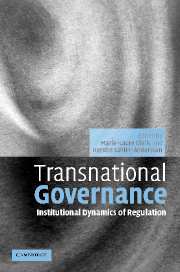Book contents
- Frontmatter
- Contents
- List of figures
- List of tables
- List of contributors
- Acknowledgments
- List of acronyms
- 1 Introduction: A world of governance: The rise of transnational regulation
- I Institutional forces
- II A dynamic transnational topography
- 7 Transnational actors, transnational institutions, transnational spaces: The role of law firms in the internationalization of competition regulation
- 8 Global enterprises in fields of governance
- 9 The transnational governance network of central bankers
- 10 Regulated regulators: Global trends of state transformation
- 11 The rationalization of universities
- III Transnational governance in the making
- References
- Index
9 - The transnational governance network of central bankers
Published online by Cambridge University Press: 22 September 2009
- Frontmatter
- Contents
- List of figures
- List of tables
- List of contributors
- Acknowledgments
- List of acronyms
- 1 Introduction: A world of governance: The rise of transnational regulation
- I Institutional forces
- II A dynamic transnational topography
- 7 Transnational actors, transnational institutions, transnational spaces: The role of law firms in the internationalization of competition regulation
- 8 Global enterprises in fields of governance
- 9 The transnational governance network of central bankers
- 10 Regulated regulators: Global trends of state transformation
- 11 The rationalization of universities
- III Transnational governance in the making
- References
- Index
Summary
Introduction
Central bankers are the wizards of our time. Pronouncements from a central bank governor are interpreted in the media in much the same way as the utterances from the Delphic Oracle: the fewer, the more secretive and the more futile they are, the more attention they attract and the more discussion they activate. Compared with the average politician, central bank governors are furthermore being treated with respect and even devotion by the media and the public at large. The present doyen d'âge among the central bankers of the world, Alan Greenspan, describes his own public statements as “constructively ambiguous” (Woodward 2000: 245). In one case, a Congressman having received a typically long-winded answer to a question at a congressional hearing, thanked Greenspan for his answer and said that he now understood the chairman's position. Greenspan ostensibly answered: “If that's the case, then I must have misspoken” (Meyer 2004: 214).
Today there is no lack of data informing the general economic debate. Private and public, national and international authorities constantly publish analyses about the past, present and future. However, the reports and releases coming from central banks have a special status. They are meticulously studied by market analysts, professional investors, civil servants and politicians alike. The knowledge production of central banks is considered particularly apt, relevant and consequential. Central bankers worldwide have become authoritative producers of knowledge, ideas and standards.
- Type
- Chapter
- Information
- Transnational GovernanceInstitutional Dynamics of Regulation, pp. 180 - 204Publisher: Cambridge University PressPrint publication year: 2006
- 14
- Cited by



